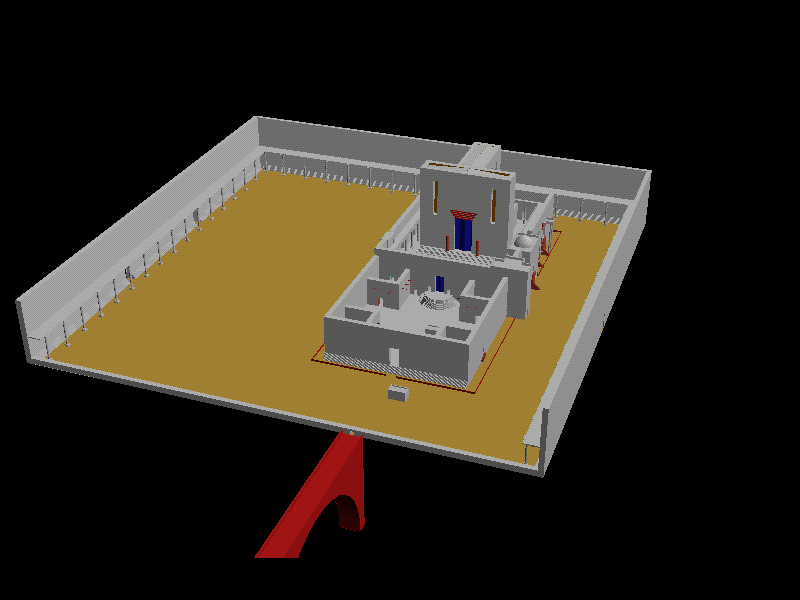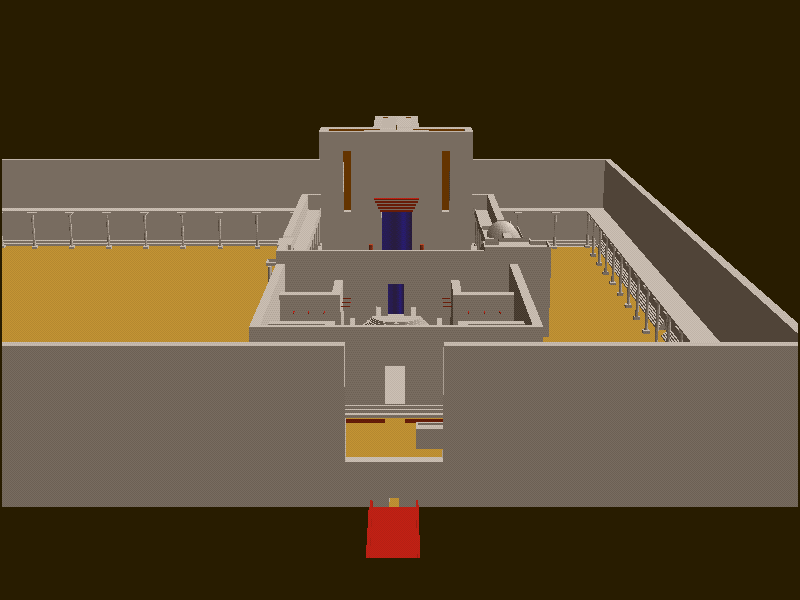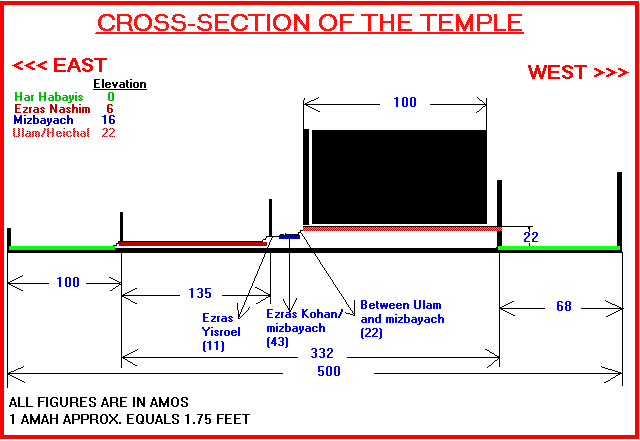The Temple Mount
We begin our actual “tour” of the Temple from the eastern gate of the Temple Mount (Har Habayis). But first, something of an overview of the mountain’s general layout might be helpful.

As you will probably have figured out on your own, the Temple was built at the top (although not necessarily the center) of a mountain – specifically, Mt. Moriah. A square area at the top of the mountain was largely leveled out and had built into it hollow domes (for both support and protection from any ritually impure objects that might have lain underground). The total walled-in area was 500 x 500 amos (Middos 2:1).
What are amos (singular: amah)?
Since the amah (also known as a cubit or, for some unknown reason, an ell) is the single most common unit of measurement in the Temple literature, that will be the unit with which we will measure “our” Temple.
How big is an amah? Anywhere between one and a half and two feet (that’s somewhere between 45 and 60 centimeters for those of you who care). The total Temple area, then, which is 500 by 500 amos, would be between 750 x 750 and 1000 x 1000 feet.
To the south and west of the mountain was the city of Jerusalem. Despite the fact that the two southern entrances to the Temple Mount were the most frequently used (being closest to the city proper), the “main” entrance was to the east – Sha’ar Shushan (the Shushan gate).
Within the walls, and a little bit off-center to the north and west, lay the main courtyard, the Azarah. The floor of this rectangular area was elevated as much as 22 amos from the floor at the outer wall to allow for the natural elevation of the mountain.
According to Rashi (BT Yoma 16a), the Azarah itself was encircled by a clear area ten amos wide (called “the cheil”) and, at its outer edge, a low fence (called “the soreg”). It was from the cheil that stairs rose to the gates of the Azarah.
According to the Rambam (Commentary to Middos 1:5), however, the fence marked the beginning of an elevated platform. Access from the Temple Mount to the top of this platform, therefore, was by way of stairs.
Contrary to what you might think, the floor of Har Habayis outside of the Azarah wasn’t simply empty space, but was crowded with at least forty-five buildings (See Tosafos YomTov to Middos 2; 1, quoting the Shiltay Giborim). Some of the buildings were used for storage, some as living quarters for Temple functionaries and one – just inside the Shushan gate – was a meeting chamber for a small Sanhedrin of twenty-three judges.
In the images of the Temple included in this book, there are none of the buildings which really filled Har Habayis (except the Sanhedrin). These were left out (1) for simplicity’s sake, and (2) in the interest of accuracy – I don’t really know how these buildings would have looked and didn’t want to include pictures which were almost certainly wrong!
THE SHUSHAN GATE
What does Shushan, the name of Persia’s capital city (made famous through its role in the Esther story), have to do with the eastern gate of the Temple? We’re told that when the Persian king Cyrus (Koresh) allowed Ezra to rebuild both the Temple and Jerusalem, he was worried about the possibility of a Jewish rebellion. To remind his Jewish subjects who was boss, Koresh instructed the builders to carve a picture of the Shushan skyline over the main entrance (BT Middos 1:3, Bartenura).
Since the eastern gate was directly opposite the entrance to the Women’s Courtyard (Ezras Nashim), which in turn sat right before the heichal itself, it could have been considered the main entrance even though most people entered and left from the south.
From Sha’ar Shushan, there was a bridge leading out across the valley, connecting the Temple to Mount of Olives. It was across this bridge that the para aduma (red heifer) was led before being burned for its purifying ashes (see Numbers, 19).
The priest (kohen) who burned the heifer had to have the main Temple building clearly in his line of sight (Numbers 19, 4), therefore the bridges and gates between the Mount of Olives and the heichal had to be built so that his vision would not be obstructed. In fact, according to Rashi, the whole eastern wall of the Temple Mount was only six amos high (as opposed to the three other walls which were as high as seventy amos) so the kohen could see over (Rashi to Ezekiel 40:5).

Other opinions shortened the eastern wall to 26 amos, and some only above the gate itself, but not along the wall’s whole length (Tavnis Heichal brought by Ezras Kohanim to Middos 2; 4. See the Ezras Kohanim further for a full discussion of this wall).

Of note: Rashi’s eastern wall of six amos partly reflected the prophecy of Ezekial (Ch. 40) that all four of the third Temple’s walls would be only six amos high.
THE JUDICIAL CHAMBERS
Just inside the eastern gate (Sha’ar Shushan) was the first of the Temple Mount’s three courthouses (according to Rashi – BT Sanhedrin 86a – this first chamber was just inside the soreg; the small fence that surrounded the Courtyard). This one (like its twin inside the Women’s Courtyard) housed a Sanhedrin of twenty-three judges. In a large basilica-like building (called the Lishkas Hagazis) in the Jews’ Courtyard (Ezras Yisroel), was a chamber for the Sanhedrin of seventy-one (BT Sanhedrin 86b).
When you consider that the city of Jerusalem itself had its own courts, and that any fair-sized city throughout the country could also boast of one, you might think of the Jews as a nation overrun by its judicial system.
It wasn’t quite so bad. All these courts were part of a pyramid-like organization, with the lower, provincial courts sending appeals and particularly hard cases to higher courts…and eventually to the Lishkas Hagazis itself.
Some types of cases – like Zaken Mamre (Deut. 17; 8-13) and Sota (Numbers 5, 15) – needed to travel through the whole court system to be legally valid. Consider also, that these courts did not meet every day. Rather, some only met on Mondays and Thursdays, and others only when called into session for a particular reason.
Finally, we should realize that Jewish courts deal with more than civil (“He owes me money”) and capital (“off with his head”) cases. Questions of the laws of the Sabbath, kosher food and even proper festival observance were all brought to the courts. The High Court was also ultimately responsible for foreign affairs and Temple procedures.
Every area of Torah law is complicated enough to need clarification once in a while. And often the only place to go for a good answer was to the leading Torah scholars – who could usually be found on one of the country’s Sanhedrins…
THE FLOOR PLAN
You might visualize Temple Mount as a series of rectangles built one atop the other – each smaller than the one below. But a picture is worth…you know…so before you plow through this chapter, sneak a quick glance at a thousand words…

The Temple Mount (everything within the outer 500 x 500 amos walls) we’ll assign an elevation of 0 amos. Slightly to the north and west of center, was a large, walled courtyard which contained both the Women’s Courtyard to the east and the Jews’ Courtyard to the west. Together they measured 322 x 135 amos. As you know, this too was entirely surrounded by the cheil (an empty area ten amos wide) and its outer fence (the soreg).
The floor of the Temple Mount was six amos lower than the floor of the Ezras Nashim. There were twelve steps from one to the other (as each stair was one-half an amah high, and one–half an amah deep). From the square Women’s Courtyard, one climbed fifteen semi-circular steps (seven-and-one-half amos) to the Jews’ Courtyard.
Between there and the Priest’s Courtyard (Ezras Kohanim – which began just 11 amos east of the main altar, and 11 amos west of the Jews Courtyard wall), were four more steps rising two and one half amos (yes, two and a half – one of these steps was actually one full amah high). West of the altar were twelve steps (six amos) leading into the Antechamber and from there it was a short (but rare) walk to the Holy of Holies.
Now these divisions were not simply a product of some architect’s fancy, they were reminders that the further “in” you went, the greater the sanctity. Each wall and fence acted as a warning, asking us: “Are you ready to go further?”
People affected by certain types of ritual contamination were not allowed past the outer walls of the Temple Mount (in fact, a metzorah – see Levit. 13 etc. – wasn’t even allowed into Jerusalem); those who had been in contact with dead bodies weren’t let past the soreg (fence); People of lighter degrees of impurity were kept from the Ezras Nashim; a regular Jew (i.e., a non-priest) was normally advised (or according to some, required) not to come within eleven amos of the altar; a priest who was not currently needed for the Temple service was not allowed into the heichal; and the Holy of Holies was out of bounds all the time except Yom Kippur (BT Mishnayos Keilim; end of first chapter – and even then, entrance was only allowed the high priest).
THE WALLS
Aside from the eastern wall (which, according to Rashi, rose to a height of only six amos), the outer walls of the Temple Mount were impressively high. Different accounts place the height anywhere between forty and seventy amos – that’s well over one hundred feet up!
The walls were five amos thick at their base, but narrower towards the top. It might have been more aesthetically pleasing to build the walls with a consistent thickness (from top to bottom), but they needed a five-amah base for support.
A surprise: We’re used to visualizing the Temple walls as layers of stones (as indeed they were). However, according to the book Ezras Kohanim (4:1), while the structure stood, the stones weren’t visible from beneath a layer of white lime plaster. As a matter of fact, nearly all the walls on the Temple Mount were covered in this lime, giving the building the appearance of snowy white mountains, glistening in the sun.
CHULDA’S GATES
As the main part of the city of Jerusalem lay to the south of the Temple, there were two entrance ways along that wall: Chulda’s Gates (Sha’arei Chulda). It was through these gates that most of the pedestrian traffic to and from the Temple passed.
In fact, during the later years of the First Temple, Chulda the prophetess stood near this wall and urged the people of her city to return to the elevated spiritual level on which they belonged. Hence, she was remembered through the names of two of the Second Temple’s gates.
Some (Tosafos Yom Tov Middos 1:3) say, in addition, that the tomb of Chulda was located in front of these gates (although not in a way that would cause problems for passing priests).
THE WOMEN’S COURTYARD
The Women’s Courtyard (Ezras Nashim) was so named, not because it was used by women any more than by men, but because under normal circumstances, this was as far west (i.e. as close to the heichal) as a woman would go.
The courtyard (whose walls enclosed an area 135 x 135 amos) had a chamber built into each of its four corners (Middos 2:5) and contained the second building of the three set aside for a Sanhedrin (this one of twenty-three judges).
The south-east chamber was called the Office of the Nazirim. There, nazirites (Jews who had accepted on themselves temporary vows to abstain from wine, haircuts and contact with the dead – see Numbers ch. 5) would come at the end of their nazir period to cut their hair, have it burnt and cook the meat of their Temple offering.
The room to the north-east was used by priests for making sure that no wood destined for the fires of the altar was wormy (and hence, unfit).
To the north-west was the chamber of metzorayim (see Leviticus ch. 12 etc. for the explanation of a metzora). Here, metzorayim at the end of their period of impurity would immerse in a mikvah and prepare themselves for the final stage of their purification.
Finally there was the storehouse of wine and oils in the south-west corner (against the east wall of the Jews’ Courtyard). There was a small flight of stairs and a door connecting this room to the courtyard above it.
Projecting from the inner walls of the courtyard were beams, built to support temporary balconies. It was during the festival of Succos (celebrated in the autumn, see Deut. ch. 17; 13 – 15) that the balconies were actually erected because it was then that thousands of Jews of Jerusalem joined with countless visitors from around the country, and, by torch-light, danced, juggled and sang in appreciation of God’s kindness to His people (Succah 51a).
Originally, the men would dance out on the Temple Mount while the women watched from inside the Women’s Courtyard. The sages saw that the intermingling could distract the participants from the seriousness of the event, so they switched it around (the men inside and the women outside – presumably so that the women could arrive after the men and leave earlier so as not to actually pass each other).
This, too, caused problems, so the sages finally decided to build balconies along the inside walls of the Women’s Courtyard (or according to the Rambam, build the walls – as the Rambam held that originally there were no walls, just a small railing to prevent people from falling over onto the floor far below).
The women stood (or sat) on top, the men below and only the greatest sages and priests danced. (incidentally, this is one of the earliest sources implying the need for a mechitza – a divider between men and women in a synagogue. See Igros Moshe Orech Chaim I 39.)
There were stairs leading up to the balconies (like the balconies themselves, these were temporary) and special doors on the north and south walls of the Women’s Courtyard (called Women’s Gates) through which the women could come and go.